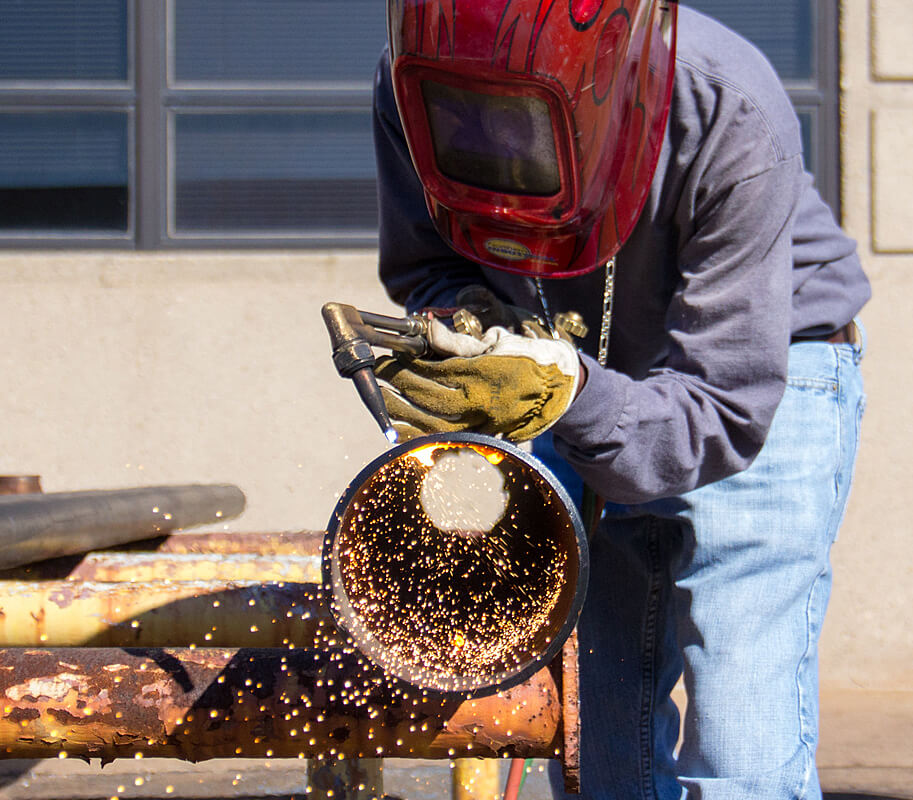
Pipefitting
Are you looking to gain real-world experience in a growing occupation that combines classroom instruction with hands-on technical training? Pipefitting may just be your calling.
COM’s NCCER Industrial Pipefitting Program prepares students for a successful career
in an entry-level position as a pipefitter helper often leading into a pipefitter
career. Pipefitters lay out, assemble, install and repair pipelines or pipe systems
that carry water, steam, air or other liquids or gases for industrial production and
process systems.
The program is noncredit and nontransferable and helps to prepare students for employment
in a growing occupation. Each course combines classroom instruction with hands-on
technical training, a critical part of building skills for this field. The program
follows the NCCER curriculum that is supported by leading construction and maintenance
companies and national associations.
Program Details
Learning Format
Face to Face
Program Length
36 weeks
Let’s Connect!
 409-933-8415
409-933-8415 ContEd@com.edu
ContEd@com.edu
Career Insights
Occupational summary for Pipefitters
43,300 Annual Job Openings
(2023-2033)
6% Projected Growth
(2023-2033)
$62,970 yr Median Salary / $30.27 hr
Additional Program Info
Upon successfully completing all three courses in the Pipefitting program, students will earn a Certificate of Completion and become NCCER Certified. Students will gain knowledge from industry professionals and will be able to:
Read and Interpret Blueprints – Understand technical drawings, isometric sketches, and piping schematics to plan and execute installations.
Measure, Cut, and Assemble Piping Systems – Work with various materials such as carbon steel, stainless steel, and PVC using industry-standard tools and techniques.
Perform Pipe Welding and Fabrication – Apply basic welding methods (e.g., SMAW, TIG, MIG) and pipefitting fabrication techniques.
Install and Maintain Piping Systems – Assemble and secure pipes for industrial applications, including refineries, power plants, and manufacturing facilities.
Follow Safety and Industry Standards – Adhere to OSHA regulations, proper rigging techniques, and job site safety protocols.
Use Hand and Power Tools – Operate pipefitting tools such as pipe threaders, grinders, and cutting torches safely and effectively.
Apply Mathematical Skills – Perform calculations related to angles, offsets, and takeoffs for precise pipe installations.
Troubleshoot and Repair Piping Systems – Identify and resolve common issues in industrial piping, including leaks and structural weaknesses.
NCCER (National Center for Construction Education and Research) certification is a widely recognized credential in the construction industry that demonstrates an individual's skills, knowledge, and competency in various craft areas. NCCER aims to standardize training and provide industry-recognized credentials for workers in construction, maintenance, and pipeline industries. The NCCER certification process involves a comprehensive curriculum, with the NCCER Core Curriculum serving as a prerequisite for all other Level 1 craft curricula. Certification typically includes both Knowledge Verification, which involves written tests, and Performance Verification, which requires practical demonstrations of skills.
- Course name: NCCER Core Course Number: CNBT-1018
-
This course is a comprehensive study of NCCER Core for instrumentation students. This course introduces students to basic job site construction safety in residential, commercial and industrial construction. Students will also learn how to select and demonstrate the proper use of hand tools, portable and stationary power tools, and related construction equipment. Students will obtain their OSHA 10 certification and credentials for NCCER Core.
- Course name: NCCER Pipefitting Level 1 Course Number: PFPB-1008
-
This course is a comprehensive study of NCCER Level 1 for pipefitting. Students will be introduced to the pipefitting trades. They will learn how to use hand tools and power tools associated with pipefitting, identify pipes, pipefittings, flanges, and fasteners; apply mathematical calculations applicable to pipefitting installations; identify equipment used in pipefitting such as oxyfuel cutting, ladders and scaffolds and motorized equipment.
- Course name: NCCER Pipefitting Level 2 Course Number: PFPB-1043
-
This course is a comprehensive study of NCCER Level 2 for pipefitting.
Students will identify and demonstrate the use of different piping systems. They will install pipe hangers and supports, sketch isometric views of piping systems, interpret piping standard and specification, and use measuring devices and pipefitting trade math.
For information about registration, please contact the Continuing Education Department at ContEd@com.edu or call 409-933-8415.
